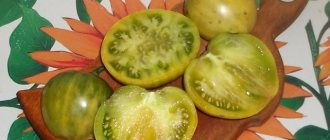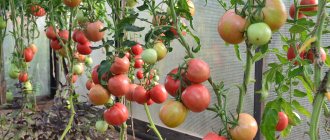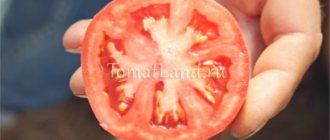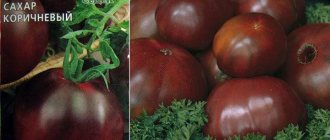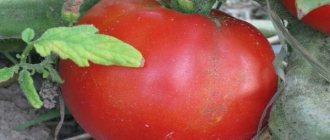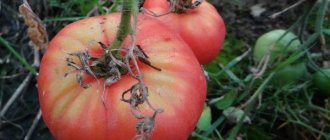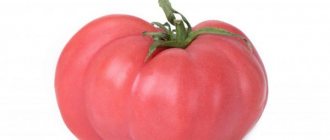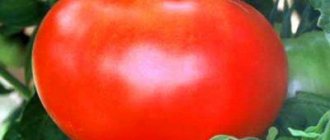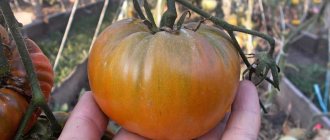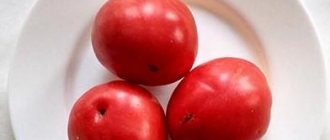Vegetable growing » Tomatoes
0
3526
Article rating
Kira Stoletova
Japan is a country with an amazing crop growing culture. The Land of the Rising Sun is a leader in rice cultivation. But not many people know that tomatoes occupy a special place in the agricultural activities of the Japanese. Japanese tomato varieties not only have excellent yields, but also amazing taste.
Characteristics of Japanese varieties of tomatoes
Tomatoes bred in Japan include a wide variety of hybrids. Today, every gardener can choose a variety suitable for cultivation with certain external and taste characteristics.
Varieties and hybrids - what types of tomatoes are there?
It’s easy to get confused in the huge selection of seeds, ending up with a meager harvest. First you need to learn to look not at the picture, but at the description on the package.
Variety and hybrid - what's the difference?
All hybrids (varieties) can be divided into several categories:
- by ripening period: ultra-early, early, mid-ripening, mid-late and late;
- by type of plant development: indeterminate (have unlimited growth of the main stem), semi-determinate and determinate (complete upward growth when a certain number of clusters are laid);
- by fruit color: red, yellow, orange, pink, green, black, two-color (striped) and others;
- according to recommendations for growing conditions: open planting, for a greenhouse or universal.
In addition, there are varietal tomatoes, and there are hybrid ones (labeled F1).
There are many differences between them. The most significant:
- It is possible to harvest your own seeds only from varietal varieties (hybrids are sterile; a plant can be grown from their seeds, but it is unlikely to bear fruit);
- hybrids have greater vitality, produce a more abundant harvest, and demonstrate increased resistance to diseases and stressful conditions.
Features of bush formation
Having familiarized yourself with the above classification, you can begin making your choice. It is worth remembering that growing indeterminate tomatoes means that they will need to be formed (usually into one or two shoots) and adjusted in height (stopped by pinching), and most varieties of tomatoes for greenhouses require pinching (removing the buds of side shoots) and tying to trellises.
Determinate ones usually do not need such procedures, although there are exceptions. Indeterminate tomatoes produce their harvest throughout the entire season, while determinate tomatoes ripen in one to three weeks.
What else should you pay attention to when choosing tomato seeds for greenhouses?
For an agricultural manufacturing company. Most organizations, if they are breeders and not resellers, have their own test fields on which they grow plants, collecting planting material from them. Foreign selection mainly offers hybrids suitable for any climatic conditions.
The geographical location of the experimental stations matters: it is better to purchase products from companies located in geographic areas similar to yours. In this case, the plants will be adapted to the climatic characteristics of the region. In greenhouse conditions, it is more important to grow ultra-early and early hybrids and varieties, as well as mid-season productive varieties with higher taste qualities.
Ultra-early and early foreign varieties
On seed packets, breeders indicate the growing season or ripening period, that is, the number of days the plant needs to enter the fruiting stage. The countdown begins from the moment the first shoots appear. Tomato seeds take an average of three to six days to germinate.
Ultra-early varieties make it possible to harvest the first tomatoes already 70-75 days after germination. Early - on the 90th day.
Japanese selection and its features
Japanese seed supplier Kitano Seeds manages to combine the benefits and beauty of vegetables with the ease of growing. The noteworthy variety “Kibo F1” belongs to indeterminate hybrids; it has powerful shoots, on each cluster of which five or six fruits of the same round shape are formed.
The average weight of a tomato is 320-340 g. There is no green spot at the base of the stalk. Even under stressful growing conditions, the hybrid sets fruit well and demonstrates resistance to cracking. "Kibo F1" is considered one of the best among pink-fruited tomato varieties for greenhouses: the tomatoes are tasty and store well.
Dutch and Swiss hybrids
Manufacturer Rijk Zwaan (Holland):
- "Abelus F1" (Abellus) is a good hybrid that demonstrates high resistance to cladosporiosis, nematodes and TMV (tobacco mosaic virus). Belongs to the Mediterranean type of tomato, the fruits are flat-round in shape, have a uniform color, dense flesh and shiny skin. The taste is excellent, the tomato aroma is noticeable. Average weight – 140-170 g.
- "Abelus F1" is considered a high-yielding tomato hybrid for greenhouses with early harvest. The growing season is 90 days. Plants are compact in shape with short internodes, growth type is indeterminate.
The Syngenta company (Switzerland) supplies “Gravitet F1” - an early productive hybrid for any greenhouses. Demonstrates resistance to TMV and verticillium. The average weight of tomatoes is 200 g, their shape is smooth, round, dark red in color, and the skin is shiny. Plants are of the generative type, that is, they are more prone to fruiting than to developing green mass, therefore they have shortened internodes and practically do not form stepsons.
Each plant forms seven to nine clusters and has a powerful root system. "Gravitet F1" produces fruits that are resistant to green spots. The hybrid is considered unpretentious and produces crops on soils of any composition.
Early varieties of domestic selection
Among the proposals of domestic breeders, in contrast to foreign ones, you can find excellent varietal varieties, and not just hybrids. Varietal tomatoes, although relatively difficult to grow, have a more pronounced taste.
Breeders of the middle zone
Agro (Moscow region) has developed the “Lastochka” variety, a hybrid of the well-known and one of the best early-ripening varieties. It is considered the optimal variety of tomatoes for greenhouses, which can withstand low light levels and are capable of producing crops even in less than comfortable conditions. Each cluster contains eight to ten round fruits of a rich bright red color. The hybrid is characterized by resistance to cladosporiosis and verticillium.
Lastochka fruits have a pleasant taste. The average weight of a tomato is 100-140 g. The plants are of indeterminate type; the first fruits are harvested 90 days after the sprouts appear.
Agro (Moscow region) offers its development - “Crimson Giant”, which is considered a successful early ripening variety (usually 100 days). Plants have limited growth, developing up to 1-1.3 m. Tomatoes are painted in a beautiful bright crimson shade and have a great taste. The average weight of the fruit is 250 g. The pulp is fleshy.
"Crimson giant" is characterized by high yield and resistance to major diseases.
Agro (Moscow region) has developed its own productive variety of tomatoes for the greenhouse. “Magic Cascade F1” is an early ripening cherry-type hybrid that produces the first harvest on the 85th day. Plants of indeterminate type, growing up to 1.8-2.2 m. The amount of foliage is small. Tomatoes in the amount of 30-40 pieces ripen on whip-shaped clusters. Average weight - 20 g. The fruits are plump and have a sweetish taste.
"Magic Cascade F1" is valued for its excellent taste, as well as resistance to diseases and verticillium wilt. The hybrid bears fruit for a long time, the yield with good feeding reaches 12-14 kg/m2.
Breeding for harsh climates
Agro (Novosibirsk) supplies the market with two of the best varieties of tomatoes for greenhouses:
“Andromeda golden F1” is a good early-ripening yellow-fruited hybrid. Its feature is resistance to low temperatures. The tomato is of a determinate type, develops up to 0.8 m. The shape of the fruit is round, the color is rich and appetizing. The average weight of a tomato is 130 g, the flesh is dense, slightly aromatic, and the taste is excellent.
“Abakan pink” refers to early-ripening varietal tomatoes. The plants are tall (up to 1.7 m) of indeterminate type. The variety is valued for its large tomatoes, which in shape and taste resemble the fruits of the famous “Bull's Heart”. “Abakan pink” shows high yield, the average weight of tomatoes is 400 g.
Read also: Calamus grass medicinal properties and contraindications
The Biotechnika company (St. Petersburg) recommends “Japanese Golden Truffle,” an early-ripening varietal tomato, for greenhouses. Planting material from Biotechnika is highly resistant to stress. “Japanese golden truffle” is a tall plant of indeterminate type, and therefore requires pinching. Plants grow in two stems, leaving three or four clusters on each; if fertilizer is applied generously, you can save five. Each cluster bears five to six fruits.
Tomatoes are bright yellow in color, fleshy, and tasty. Their shape looks especially original; the fruits look appetizing when preserved. To accompany yellow-fruited plants, you can plant a variety of this variety with black colored fruits.
Mid-early and mid-ripening tomatoes
The average growing season usually lasts from 110 to 120 days. The ripening of tomatoes directly depends on the conditions of their keeping: the microclimate in the greenhouse, the composition of the soil, the amount of watering and the quality of fertilizing. Therefore, the dates given by seed producers are approximate; you need to focus on them only in order to calculate the sowing time.
American selection Seminis (USA)
“Mathias F1” is a very popular high-yielding tomato variety for greenhouses in many countries, since its feature is the formation of large (250-290 g) fruits in a variety of soil and climatic conditions. "Mathias" is resistant to low temperatures. The plant is indeterminate; breeders recommend stopping growth when seven to ten clusters are formed, leaving four to five tomatoes on each of them.
The hybrid belongs to the “beef tomato” segment, that is, the fruits are very fleshy. “Mathias” demonstrates resistance to cracking, as well as a number of viral and fungal diseases: TMV, Fusarium race 1-2, Alternaria.
Varieties for the middle zone
Agro (Moscow region) developed “De Barao” - one of the most reliable and well-known varieties of tomatoes for indoor soil. The growing season is 120 days. Tomatoes are indeterminate; powerful shoots can reach two meters in height. Fruiting in the middle zone begins at the end of July and lasts until autumn. It is considered the most productive variety of tomatoes for greenhouses.
The fruits have an elongated shape, an average weight of 60 g, and have an excellent taste. There are varieties with pink, red and black skin, which are good both in vegetable salads and canned.
The agricultural company “SeDeK” (Moscow region) sells “Golden Fish” - a medium-ripening variety, the first fruits of an elegant yellow color ripen on the 110th day. Plants are of indeterminate type, reaching 1.8-2 m. Tomatoes have an elongated shape with a “spout” at the end. Average weight 110 g. The pulp is dense, sweet, fleshy.
The variety is characterized by resistance to temperature changes, is valued for its long fruiting and interesting shape of tomatoes, suitable for canning and for consumption “from the bush”.
Agro (Moscow region) supplies tomato seeds for greenhouses “Lezginka F1” - a medium-ripening hybrid with an unusual fruit shape: slightly elongated, pointed downwards. Tomatoes have a bright red color, shiny skin and tasty juicy pulp. Average weight – 140 g. The brush is long and does not break. The hybrid is resistant to TMV, blossom end rot, fusarium and cladosporiosis.
Seeds for harsh climates
The agricultural company Seeds of Altai (Barnaul) sells:
“Ox ears” is an excellent variety of Altai selection that produces high yields. Plants are indeterminate. Tomatoes have few seeds, average weight 140 g, the flesh is dense and fleshy. The shape of the fruit is very interesting, and the variety is also valued for its excellent taste. Despite their plum-like shape, the tomatoes are quite juicy inside.
“King of Siberia” is a universally grown varietal tomato with tasty and tender golden-yellow fruits. With high-quality fertilization, the weight of tomatoes on the first cluster can reach 800-900 g. The plant is determinate, grows up to 1.2-1.5 m. It is recommended to plant seedlings at the age of 60 days, which have already formed one cluster. The distance between copies is left at least 40 cm.
Yellow Mimi
The Elou Mimi tomato is included in the State Register of Vegetable Crops. It is zoned in the Moscow, Vladimir, Tula, and Kaluga regions. It is grown in Bryansk, Ivanovo, and Ryazan. This is a cherry tree that is distinguished by its tall growth. Closed ground is recommended for it:
More on the topic: How does the Fat Jack tomato grow?
| № | Helpful information |
| 1 | Japanese tomato bright yellow, round, sweet |
| 2 | weight 16 g; harvest 6 kg/bush |
| 3 | hybrid plant, resistant to viral and fungal infections |
For Yellow Mimi, it is recommended to use mulching film. It retains soil moisture well. In this case, plant care is simplified. Watering is carried out once every 3 weeks.
For tomatoes that are under the film, artificial pollination is used. Ovarian stimulants are used. The inflorescences are irrigated so that the ovary is better formed. Fertilizers that contain potassium, phosphorus, magnesium, and boron are first introduced.
Anti-infection treatments are organized as needed. For tomatoes, fertilizers with mineral complexes are introduced.
Varieties from private breeders
Recently, purchasing planting material from private breeders has become increasingly popular, which is not surprising. From such people you can buy not only proven seeds of reliable tomato varieties for greenhouses, but also rare exotic varieties, already adapted for growing in your climatic conditions.
You can purchase their seeds online, orders are sent by mail.
The Gusev family offers “Paul Robeson,” an ancient variety selected in the USSR back in the 1930s. It was named after an opera singer who was visiting the country at that time. It is considered one of the best varieties of black-fruited tomatoes in all respects. Plants of indeterminate type. Early ripening. The tomato is universal: it can be grown in any type of soil (in greenhouses, open).
Lidiya Ioshimtseva (Chelyabinsk region) developed the “Australian” tomato, a tall, mid-season variety. The fruits have a universal purpose. The shape is round, slightly flattened. The color is honey-red. The pulp is juicy. The average weight of a tomato is 600 g. The yield of the variety is high. Plants reach 1.5 m. Australian is resistant to major diseases, tomatoes have a great taste and aroma.
The variety of hybrids and varieties is extremely large. Among the many varieties, you can choose any options for both home and commercial cultivation.
Some are more productive, others are resistant to diseases and stressful conditions, some of them are tall or short, with a variety of fruit colors, but the best varieties of tomatoes for greenhouses will still be those that are the most delicious - the choice is huge.
Japan is a country with an amazing crop growing culture. The Land of the Rising Sun is a leader in rice cultivation. But not many people know that tomatoes occupy a special place in the agricultural activities of the Japanese. Japanese tomato varieties not only have excellent yields, but also amazing taste.
Characteristics of Japanese varieties of tomatoes
Tomatoes bred in Japan include a wide variety of hybrids. Today, every gardener can choose a variety suitable for cultivation with certain external and taste characteristics.
Advantages
According to gardeners, Japanese varieties have a number of advantages over domestic varieties:
- 100% seed germination;
- sweet rich taste;
- tomatoes are disease resistant;
- do not require additional feeding;
- long fruiting period;
- friendly ripening of fruits;
- excellent taste;
- universal table use: salads, sauces, pastas, juices, preserves;
- beautiful presentation;
- are stored for a long time;
- not whimsical in care.
Japanese tomatoes are deservedly popular all over the world, they have proven themselves positively in all respects; vegetable growers, farmers and amateur gardeners positively characterize almost all known Japanese varieties of tomatoes.
Popular Japanese tomato varieties
The main suppliers of Japanese varieties are two companies: Sakata and Kitano. Reviews say that these suppliers have earned the respect of customers not only for the quality of planting material but also for their affordable prices. The Japanese line of tomato seeds includes a large number of different hybrids, suitable not only for open ground, but also for growing in greenhouses. Indoor tomatoes are also popular. But, due to different climatic conditions, not all Japanese varieties have received recognition in Russia. Best of all, they have taken root among domestic gardeners:
- Japanese Crab tomato;
- Japanese Truffle;
- Japanese creeping tomato;
- Senkar tomatoes;
- Chisato tomatoes;
- Japanese Rose.
Tomatoes TMAE 683 f1 deserve special attention. This hybrid is ideally suited to domestic climatic conditions. Can be grown both in open ground and in greenhouses.
The main advantage of this variety is that TMAE fruits can set even during sudden cold snaps. In addition, the productivity of the Japanese is impressive. From one bush you can collect up to 5 kg of tasty, shaped vegetables.
Dwarf
The Japanese Dwarf tomato is suitable for open ground and balcony growing. The variety is mid-season, determinate, low-growing. The height of the bush is 45-50 cm. The plant is not very spreading. He is tied to a peg. Axillary shoots are removed so as not to thicken the bush:
- the berry is round, bright red, juicy;
- weight 50-60 g. The lower fruits can gain a weight of 80 g; 2-4 kg/plant;
- Hybrid variety, disease resistant.
The tomato is watered moderately and mineral fertilizers are added. Plants are protected from direct sunlight with a net. A green mosquito net is installed on the balcony. It transmits light well, provides ventilation, but reduces the access of UV rays.
Characteristics and description of Japanese tomatoes
Growing Japanese tomatoes is a very interesting and entertaining activity. Today, every owner of a plot of land can choose a variety that is suitable for certain characteristics. Some of the foreign hybrids have low growth rates and can be grown in a room or on a balcony. Others are intended only for street landing.
For a novice gardener, a large assortment of “Japanese” products can frighten, confuse and mislead. Tomato varieties recommended by sellers do not always meet the requirements that consumers expect from them. Therefore, experts recommend that you first familiarize yourself and thoroughly study the “new product” on the domestic market before making your choice.
Read also: Lazy cabbage rolls with Chinese cabbage in a slow cooker
Japanese Crab
The popularity of the Japanese Crab tomato is caused by the taste of its fruit. This tomato is very sweet, its flesh is dense and has almost no seeds. This description of the vegetable makes it ideal for preparing cold appetizers. In addition, the connection between the name of the variety and the vegetable itself is also interesting. The fact is that the shape of a tomato resembles a crab, since the fruit of this hybrid is slightly flattened and has noticeable protrusions on top.
Domestic gardeners who grow this Japanese tomato variety highlight the following features:
- This tomato bush is tall. The height of the stem, with proper care, can reach 160-170 cm.
- This "Japanese" has large thick green leaves. But the impressive landscaping doesn't overshadow the clusters of pink tomatoes.
- Productivity is high and long lasting. When grown in a greenhouse, you can have a good supply for the winter, because this variety actively produces crops until mid-autumn.
- Resistant immunity to diseases and pests. With proper care, the risk of rot, tobacco mosaic and other diseases is minimal.
A person who decides to plant this hybrid on his plot of land must go through the standard period of growing seedlings from seeds and planting them. You should not start sowing in open ground right away, because the chances of seedlings appearing are minimal.
Japanese Truffle
The fruits of this variety can change their color
Characteristics of the Japanese Truffle tomato is its advantage. The fact is that the fruits of this plant, in addition to their amazing taste, can change their color depending on the duration of ripening. So, a tomato that has set on a bunch may be pink, but after a few days it will turn bright red. In addition, when overripe, such a tomato turns black.
The description of this variety also has its own characteristics. The bush of this hybrid is vigorous, with dense landscaping. The fruits are shaped like a pear. Their pulp is dense, with a minimal number of seed chambers. The skin is not susceptible to cracking. These qualities of tomatoes make them suitable for transportation and long-term storage.
Japanese creeping
The description of the Japanese creeping tomato makes this variety unlike other varieties of tomatoes. Of the “Japanese”, this is the shortest tomato. Its peculiarity is associated with the size of the shoots, which spread 60-70 cm wide. The height of such a bush is small and rarely exceeds 25 cm in height.
Numerous reviews about this hybrid are related to its appearance during the flowering period. The fact is that its flowers are bright yellow. Flowers, like golden jewelry, decorate a spreading green bush. In addition, the fruit ovaries that form later also attract attention. Small clusters of red tomatoes, weighing no more than 100 grams, resemble in their appearance the world-famous Cherry tomatoes. In addition, these mini tomatoes are great for canning.
Senkara
No less popular in Russia and neighboring countries are the varieties “Senkara” or “Japanese Rose”. These hybrids have average height. They require molding into 1-2 stems when grown in open ground or in a greenhouse. The fruit cluster of the Senkara variety has impressive size and weight. A “bunch” of large pink tomatoes, weighing 250-280 grams, will ripen by mid-June. The indicators of the Japanese rose are more modest. The cluster of this hybrid includes 5-6 bright red tomatoes, weighing no more than 140 grams.
Chisato
The hybrid "Tisato" deserves special attention. Among the people, such a tomato deservedly received the title of giant. The fact is that this powerful plant actively grows and bears fruit in any climatic conditions. The only thing this “Japanese” doesn’t like is frost. The variety gives a good harvest on any soil, despite rainy or hot summers. From one bush you can collect up to 10 kg of fruit. In addition, the brush can only hold 5-6 tomatoes, weighing 250-280 g.
Features of growing tomatoes
The tomato market is large and in demand. Therefore, there will be no problems purchasing seeds. Having decided to plant Japanese tomatoes, you need to have a good understanding of agrotechnical features. After all, some of their foreign plants have their own, individual characteristics, taking into account which you can achieve the desired harvest.
You should carefully familiarize yourself with the growing features
Buying seeds and sowing them in infertile soil is a rash act. Every gardener, experienced or someone who is just exploring the world of plant growing, should know about all the intricacies of planting tomatoes. Therefore, you should select suitable soil for the purchased hybrid and prepare the seeds for planting. For growing seedlings, a mixture of ordinary soil and humus is suitable. Seeds sown in pots are covered with polyethylene and placed in a warm place until seedlings emerge.
Depending on the variety, seedlings are prepared for picking 90-140 days after sowing. Transplanting to a new place, outside or in a greenhouse, also has its own characteristics.
Expert advice
- Add mullein to the garden soil. Fertilizing the soil with manure will provide the planted plant with the microelements necessary for active growth and fruiting.
- When digging up the soil in the spring, add complex mineral fertilizer to the soil.
- Add ammonium nitrate to the soil.
Fertilizing garden soil in advance allows plants to quickly adapt to new conditions without various risks and problems. When the seedlings get stronger and begin to produce flowers, it is necessary to pay more attention not to fertilizers, but to watering at the root.
Other preventive measures are also important, such as loosening the soil and ventilating greenhouses. Foreign tomato varieties suffer no less from lack of air than those varieties that belong to domestic selection. Systematic loosening of the top layer of soil, as well as ventilation of the greenhouse, will relieve the seedlings from problems with the formation of rot and increase the yield.
Features of growing and caring for the variety
For cultivation in film greenhouses, seeds are sown for seedlings in the second half of February. For open ground, plant 2-3 weeks later. Before planting in the garden, tomatoes grow for 60-65 days.
The soil for the Japanese tomato is prepared loose, fertile, with a slightly acidic or neutral reaction. The substrate “Universal” or “For tomatoes” is suitable.
You can make the mixture yourself by combining peat, turf soil, sand (vermiculite) and humus in equal parts. For every 5 liters of mixture, add mineral fertilizer for vegetables (Fertika, OMU), 2 tablespoons.
Seeds are sown dry or soaked in warm water with a germination stimulator to a depth of 7-8 mm, at intervals of 3 cm. Shoots appear on days 5-7, at a room temperature of +25 degrees.
Caring for Japanese seedlings consists of standard manipulations: watering, picking. Plants are kept in a bright place, at a temperature of +18 degrees at night and +22 during the day. Water the seedlings 2-3 times a week.
To eliminate the possibility of tomatoes being damaged by blackleg, watering is alternated with irrigation with a slightly pink solution of potassium permanganate.
In the phase of 3-4 true leaves, the tomatoes are planted in separate glasses, deepening the stems to the cotyledons. The volume of the pots is at least 800 ml. For better development of the root system, it is recommended to pinch the central root a quarter of its length.
Immediately after planting, strong stakes are driven in near the plants. The Japanese tomato grows to almost 2 m, so it needs staking of the stems. In open ground, tomato growth is limited by pinching the top at a height of 140-150 cm. To increase the yield, the variety is formed into 2 stems, leaving only the first lower stepson. The remaining shoots are removed.
The Japanese tomato variety needs to be fed every 18 days from the moment the plants are planted in the ground. Approximate feeding scheme:
- 2 weeks after planting, nitrogen fertilizers (chicken manure, urea) are added to the soil;
- during the flowering phase, feed with a complex mineral preparation + microelements;
- During the period of mass fruiting, a full set of elements is needed (nitrogen, phosphorus, potassium).
Water the tomatoes regularly, avoiding waterlogging of the soil.
Diseases and pests of Japanese tomatoes
Most of the plants bred in the Land of the Rising Sun are not susceptible to frequent disease infections and do not suffer from pest attacks.
But errors in care can still “play” against the planted crop. The declared resistance of immunity without preventive spraying, ventilation of greenhouses and other care features is significantly reduced. Therefore, you should be aware of what problems may stand in the way of a gardener in growing tomatoes. Most often, tomato varieties from the East suffer from:
- Phytospora and cladosporiosis. These diseases appear due to poor climatic conditions. The main reasons are high humidity and high air temperature.
- Top and root rot. Occurs due to lack of air in the greenhouse and high humidity. In addition, root rot occurs more often due to excessive watering.
- Aphid. It appears very rarely in greenhouses. It's very easy to fight her. You should wipe off the plaque formed on the foliage with a damp sponge soaked in soapy water.
We know Japan, an amazing country in all respects, as the world leader in rice cultivation. However, few people know that one of the most important places in agriculture in the land of the rising sun is the cultivation of tomatoes. Japanese tomato varieties have fairly high yields and amazing taste. Japanese selection of tomato seeds is distinguished by a large number of different hybrids, which are suitable not only for open ground, but also for growing in greenhouses.
Bella Rosa
Igor Nikolaev
auto RU
The Bella Rosa tomato variety is a hybrid, determinate plant. The fruits ripen in 90 days. Tomatoes are grown in open ground. Plants are resistant to temperature changes and precipitation and do not get sick. Their care is simplified:
- The fruit is red, flat-round with dense and juicy pulp. There are few seeds;
- Bella Rosa variety is large-fruited. A tomato weighs more than 300 g;
- gardeners harvest 10 kg/m2.
More on the topic: How to grow a Hospitable tomato?
The producer of the Japanese tomato Bella Rosa is the Sakata company. According to gardeners, the seeds sprout vigorously. The seed does not need to be processed. Sprouts appear in 3-4 days. The ripening temperature is 25 C. A greenhouse effect is created for the seedlings.
Some interesting things
The tomato arrived in Japan after a long journey that took it from Central America to Portugal, from Portugal to southeastern China, and finally from China to Japan. The fruit was first mentioned in the country in a 16th-century painting where it was called Togaki, or Indian persimmon.
Read also: Tula geese breed description
Tomatoes are rich in vitamins C (helps the body's immune system stay healthy), K (maintains strong bones) and A (keeps hair and nails in good condition). When cooked, the large amount of antioxidant lycopene present in tomatoes is easily absorbed by the body.
The most interesting varieties of Japanese tomatoes
Amai tomato variety
This is a highly productive hybrid tall variety that bears fruit very well in the early and mid-season. It has medium trunks with good leaf cover and fruits that are oval and uniform in shape. Their flesh is very soft and has an excellent flavor, with a good balance of sweetness and acidity and a complex aroma. Plants will continue to produce throughout the season and offer good disease resistance.
Tomato variety Japanese Black Trifele
The pear-shaped fruits have green-veined shoulders that extend into a polished red body and finally into a darkened, almost black base. The fleshy fruit has a complex and rich flavor with a slight hint of chocolate. The fruits reach 6-10 cm in length and width and are very resistant to cracking.
Tomato variety Katana
It is a consistent producer of uniform, firm, round fruit with smooth shoulders. A hybrid variety with dark red fleshy fruits, it produces a continuous harvest throughout the season. Resistant to fusarium races, verticillium, nematodes, and tomato mosaic virus.
Grandeur tomato variety
This high-quality hybrid from Japan is a vigorous producer of uniform, firm, dark red tomatoes with a green shoulder. Large fruits can weigh more than 0.5 kg each. Early ones have large leaves and short internodes. Hardy plants produce 5 to 6 fruits per cluster and are resistant to sunburn and cracking. Resistant to verticillium, fusarium, stemphylium and TM1. This tomato is an excellent choice for home or commercial growing.
Tomato variety Momotaro Tough Boy
This is a Japanese variety of pink type, with medium sized leaves. The fruit weighs about 210 grams with an excellent taste with a high sugar content. High resistance to gray leaf spot, root knot and intermediate resistance to bacterial wilt.
Tomato variety Momotaro Fight
This is a very early ripening hybrid pink tomato with a deeply flattened shape and a green shoulder. It can withstand high temperatures. The plants have medium-sized leaves and medium-length internodes. The aroma is excellent with a high sugar content, best suited for fresh consumption. Resistant to leather cracking. Produces 3-4 fruits per cluster.
Tomato variety Odoriko
This vigorous plant produces a good harvest of large, pink-fleshed tomatoes. The variety requires garter. The fruit is of exceptional taste, without blemishes, which makes it
An excellent choice for the home garden and gourmet market. Resistant to diseases, root knot nematodes, tomato mosaic virus and leaf mold.
Tomato variety Barlow Japanese
The hybrid variety produces a pink tomato. Plants are disease resistant and very productive. Large juicy fruits with an old-fashioned, excellent balanced sweet taste, growing up to 400-700 g.
Tomato variety Solanum lycopersicum
This Japanese hybrid variety produces high yields of large, pink, heart-shaped tomatoes. The fruit has a richer flavor than most other rose varieties. They are very juicy and meaty with few seeds. Ideal for sandwiches, salads, slicing, or making a rich tomato sauce. The plant has fern-like foliage. An excellent choice for personal plots.
Japanese rose tomato variety
This is the best variety for sauce, pasta and canning. Thick walls, dense pulp and huge yields. Tomatoes weigh 25-280 grams each. Resistant to vertical wilt (V), fusarium wilt (F) and nematodes (N).
Tomato variety Chisato
This is another Japanese tomato variety, and it is very good. The fleshy and medium sweet fruit with fruity undertones will surprise you because it is not a luxurious fruit. The hardworking vines produce a really good amount of fruit that ripens in about 80 days after establishment. Ideal for sandwiches, fresh food and cooking.
Tomato variety Kumato
The fruits ripen from the inside and their color changes naturally from dark brown to golden green. They are unique in that the fruits are edible at all stages of maturity. When the color is dark brown-red with no green, the flavor is mild and is best used for cooking. When they are brownish in color and covered in red areas, these tomatoes are at their peak flavor, and when they turn brown with a slight green overcast, they are at the ideal stage for eating. The fruit is juicy with a firm texture and has a higher fructose content than traditional red tomatoes, resulting in an unusually sweet, complex flavor that is juicy and also slightly tart. Kumato tomatoes are perfectly round and about the size of a golf ball and grow on tall, twining stems that are often recommended for staking.
Tomato variety Indigo Blue Beauty
A large variety characterized by a dense and fleshy fruit texture. The fruits are generally round in shape with a slightly flattened figure, averaging four to eight ounces in size. Their internal flesh is orange-pink with small pockets for seeds, and the skin is dark red with bright blue highlights on the shoulders or where the fruit receives maximum sun exposure. It is a sweet and aromatic tomato with low to moderate acidity. Indigo Blue Beauty tomato stems continue to ripen throughout the growing season on long vines that often require staking. This productive variety is resistant to sunburn and cracking, and the fruits hold well on the stem for a long period of time.
Senkara tomato variety
Its large, fragrant, dense fruits have a dark red skin and a squat, somewhat flattened shape. Their soft flesh is juicy and meaty, offering a strong and pungent flavor. Vigorous early season plants reach an average of 50cm in height and produce masses of fruit weighing 150-180g throughout the season.
Tomato variety Hitomaks
The early hybrid tomato is a unique hybrid with a distinctive sweet but tangy tomato flavor, but with a higher yield and significantly fewer defects. The plant produces smooth, flattened, ball-shaped fruits, on average 250-280 g. The variety is high in acidity and juiciness, and its plants continue to produce new fruit throughout the season along extensive stems with green leaves. The variety has an upright growing habit, reaching up to 70 cm in height and often requiring staking to support its large yield.
Tomato variety Aysan
A mid-late variety, the tomatoes are large, plump, with a thin dark red skin. Their fleshy flesh is the same color as the skin, with a bouquet of aroma similar to rose. The tomatoes are full-bodied, with an excellent, strong tomato aroma. Large plants with regular leaves produce high yields of fruit from 220-250 grams in clusters of four to six fruits along vigorous stems, with serrated leaves.
Tomato variety Yadviga
Super early hybrid variety, average fruit weight - 200-220 g with smooth glossy skin, rich red color with strong marbling. The dense inner flesh is almost seedless, red, with a texture somewhat similar to a peach. The taste is quite sweet, fruity, with notes of apricot and very low acidity. Round tomatoes are resistant to cracking and very heat tolerant. High-yielding, indeterminate tomato plants produce sweet and juicy fruit on long vines that reach heights of five to ten feet.
Description of Japanese tomato
There is a version that the variety was bred by a family of experienced gardeners in the Nizhny Novgorod region. The seeds of this tomato cannot be found in regular stores; they can only be purchased in amateur collections. Despite this, many gardeners want to get it for their own garden.
Main qualities:
- indeterminate variety;
- the stem is dense and tall, reaches 2 meters in height;
- the fruits are large, fleshy, up to 300 grams;
- the bush is not spreading, the leaves are medium;
- simple raceme, up to five inflorescences;
- well formed from two stems.
The fruits are large and fleshy, pink in color, with a yellowish corolla at the top. The shape is round, with a pointed tip, and in cross-section resembles a heart. The taste is rich, with sweetish notes. The tomato skin is thin and tender, so its use in salads is very successful. The sweetish taste and beautiful shape will decorate any table. Excellent in sauces and pastes, easy to grind.
One of the most pleasant features is its good resistance to climatic conditions and diseases. Thanks to its high yield, the plant will delight you with delicious fruits until late autumn.
